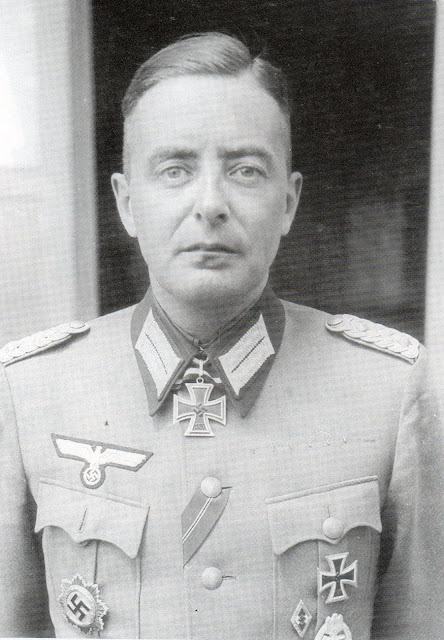Hitler Youth Shooting Badge.
Instituted – 1936
Rarity – Scarce
Known Makers – M1/14, M1/63, M1/66, M1/77, M1/120
This award consisted of a 21 mm round, semi convexed badge that had a small, raised edge line with three similar lines at 1 mm intervals. The whole of the badge was then in filled with opaque black enamel. On to the centre of the badge was superimposed crossed rifles, the tip of the butts and barrels just overlapping the edge of the badge. These measure 22 mm and over them, at the centre, is superimposed a small Hitler Youth membership diamond that measures 13.5 mm by 9 mm.
The reverse has a safety pin attached by a round plate and superimposed is the RZM logo M1/ and the manufacturer's number. Pre war issues are well made with good enamel work but wartime examples are often of a much lower standard of execution, with paint replacing the enamel and even plastic the metal. The reasons for this could be to do with War Time economies, but this is not confirmed.
Reichsjugendführer Balder von Schirach, to stimulate competitive shooting amongst members of the Hitler Youth, instituted the award in 1936. The competitor had be of the age of 16 years or older. The HJ used .22 calibre small-bore rifles. The target is a circle divided into 11 rings and a bull’s eye. Outer ring was worth 1 point. Bull’s eye was worth 12 points. Distance for the HJ member was 50m. Target was changed after 5 shots. The test was firing five shots from a prone position with rifle supported on a sandbag, five from the prone position with the rifle unsupported and five from a kneeling position with unsupported rifle. Prone position with weapon supported the member must achieve 25 points with no single shot being worth less than 4 points unless the target is hit 5 times. Prone position weapon unsupported the member must achieve 20 points with no single shot being worth less than 3 unless target is hit 5 times. The results were recorded in a special shooting book. Authorised recipients were permitted to wear the badge on the left breast pocket of their uniform. It appears that there was some early confusion concerning the manner of wear, as some recipients wore the badge on the right breast pocket. Accurate figures of numbers awarded are available up to the end of 1943 and the number recorded is 273545. A Schiessbuch or Shooting Book was given to the competitor and this was used to record the qualifications of the HJ member. This was then used as proof of attainment and allowed the member to wear the badge.
Hitler Youth Shooting Badge Marksman.
Instituted – 1938
Rarity – Scarce
Known Makers – M1/14, M1/63, M1/66, M1/77, M1/120
This badge comprises the same design as that described in Hitler Youth Shooting Badge with the addition of a 2 mm ring of 25 oak leaves, which increases the overall size of the badge to 25 mm. In some cases the badge has the enamel subsisted for a matt paint finish. The reasons for this could be to do with War Time economies, but this is not confirmed.
Reichsjugendführer Balder von Schirach instituted the badge in 1938. Again the competitor had be of the age of 16 years or older. The test was increased to ten shots as previously described with the addition of ten rapid fire from a standing position with an unsupported rifle. Prone position with weapon supported. Must achieve 35 points with no single shot being worth less than 6 points unless target is hit 5 times. Prone position weapon unsupported. Must achieve 30 points with no single shot being worth less than 5 unless target is hit 5 times. Authorised recipients were permitted to wear the badge on the left breast pocket of their uniform. Accurate figures of numbers awarded are available up to the end of 1943 and the number recorded is 31904. A Schiessbuch or Shooting Book was given to the competitor and this was used to record the qualifications of the HJ member. This was then used as proof of attainment and allowed the member to wear the badge.
Hitler Youth Shooting Badge Champion Shot.
Instituted – December 1941
Rarity – Rare
This badge comprises the same design as that described in Hitler Youth Shooting Badge Marksman with the oak leaves being gilded. In some cases the badge has the enamel subsisted for a matt paint finish. The reasons for this could be to do with War Time economies, but this is not confirmed.
Reichsjugendführer Balder von Schirach instituted the badge in December 1941. Again the competitor had be of the age of 16 years or older. The test were the same as previously described but the scores required in all of them had to be of a higher nature to gain the badge. Prone position with weapon supported the member must achieve 45 points with no single shot being worth less than 8 points unless target is hit 5 times. Prone position weapon unsupported the member must achieve 40 points with no single shot being worth less than 7 unless target is hit 5 times. Kneeling position the member must achieve 30 points with no single shot being worth less than 5 unless target is hit 5 times. Authorised recipients were permitted to wear the badge on the left breast pocket of their uniform. Accurate figures of numbers awarded are available up to the end of 1943 and this only records 852 being rendered. A Schiessbuch or Shooting Book was given to the competitor and this was used to record the qualifications of the HJ member. This was then used as proof of attainment and allowed the member to wear the badge.
Hitler Youth Member wearing the Shooting Badge.
Hitler Youth Shooting Badge Book - cover.
Hitler Youth Shooting Badge Book - 1st page.
Hitler Youth Shooting Badge Book - 7th page.



+student+1+REVISED+IMAGE.jpg)
















